There are as many different types of usability issues as there are people. Identifying usability problems and solutions to these problems is a collaborative process between the consumer, the CIL specialist and local community resources.
Usability issues can be wide and varied in nature. They can involve making physical modifications to someone’s home—from those that are very technical and difficult in nature to others that are quite simple and inexpensive. Some problems may involve policy issues or negotiating with the landlord or a Homeowners’ Association. Still others may revolve around assistive technology needs or managing personal care assistant services.
Finding solutions to these varied problems will depend on the ingenuity and creativity of the consumer, CIL staff, and community partners working together.
Building community relationships to support Home Usability
Communities are unique, just like people! What resources are available and what relationships exist to support those resources varies from community to community. One way to start thinking about and developing your network is to think about who you already know. What connections does your center already have? Do you have a resource or referral list that you work with when handling housing calls? Who is on that list and is there anyone who you think would be willing to participate in this network?
Create a list of individuals or organizations that you already know.
- Are there individuals and organizations that you should reconnect with?
- Is someone or some organization missing from the list? (check out our list of potential community partners for ideas)
- Who else do you need to reach out to?
Create another list of organizations and individuals that are missing and that you think would make good network members. Also include on this list folks from previous projects whom you feel you should reconnect with.
Talking about home usability to community members
Once you have developed your list of potential community partners it’s time to connect! Does your center produce a newsletter? Are there other local disability organizations or housing organizations that you work with? Do they have flyers or newsletters? These are all potential communication and outreach avenues. However you do your outreach, there are three main elements to successfully building community relationships for home usability.
- Show up
- Know your audience
- Communicate effectively
Check out our resource guide on Promoting Home Usability to identify ways to talk about the program with potential community members and with others within your organization.
Resources
Potential Home Usability Partners: You want a diverse group of individuals as part of your network because it is important that your group have a diverse knowledge base for addressing a variety of needs. Below, we outline some of the key topics on which you and your network members should have some expertise.
The Community Toolbox is an excellent resource for developing new programs and engaging with community members. In this expansive toolkit you can find information on:
- Conducting a SWOT (Strengths, Weaknesses, Opportunities, Threats) analysis: This is a strategy that will help you identify what areas of home usability your organization is already successful in and areas where you may need to strengthen community partnerships.
- For example, your CIL may already be doing excellent work with a fair housing organization to support consumers with reasonable modification/accommodation requests (a strength). However, your organization may be limited in the support you can provide to consumers about potential contractors or companies that can make the modifications or provide cost estimates (a weakness). However, a CIL staff person has an uncle who works for a local contractor (an opportunity) but the company is short staffed making it challenging to engage him in the work (a threat).
- Identifying community assets and resources
- Creating and maintaining community partnerships
